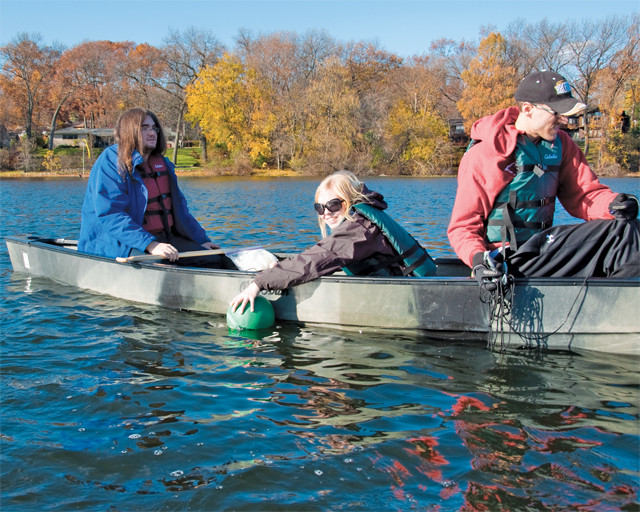
by Kate S. Zalzal Tuesday, January 17, 2017

Students collect measurements of conditions in Woods Lake in Kalamazoo, Mich. Credit: Lynne Heasley.
The U.S. Geological Survey reported that approximately 30 million tons of road salt were applied to U.S. roads during 2015 to speed up the melting of snow and ice. Recently, scientists have observed increasing impacts on ecosystems and water quality linked to its application. New research, for example, finds that road salt influx is geochemically disrupting the ecosystem health of urban lakes in Michigan, and it may even lead to rising methane emissions from the lakes.
“When you apply road salt, it’s going to wash into streams and the shallow subsurface and make its way into lakes,” says Carla Koretsky, a geochemist at Western Michigan University who presented her findings at the Geological Society of America annual meeting in Denver, Colo., last September. Koretsky monitors urban lakes in and around Kalamazoo, Mich., and has observed changes in temperature, pH, conductivity, nutrients and salinity within the water column — changes that she links to road salt input.
In addition to the possible salinization of drinking water supplies, changes in lake chemistry can be acutely or chronically toxic to aquatic life, says Sujay Kaushal, a biogeochemist at the University of Maryland who was not involved in Koretsky’s recent research.
Koretsky’s monitoring work began in 2009 as part of a field geochemistry course in which she and her students took monthly measurements in two urban, road salt-impacted lakes, Woods Lake and Asylum Lake. “We found stunningly high chloride levels in these lakes indicative of road salt input,” she says, noting that studies of other urban waterways in Michigan, including the Great Lakes, also have recorded increasing chloride levels in recent decades.
Little historical geochemical data on Woods Lake exist, but it was known as a popular swimming lake in past decades, Koretsky says. Now, the lake is too clogged with algae to swim, stemming from high nutrient inputs linked to urban development. This thick algal growth further degrades water quality because, as algae decompose, bottom waters can become anoxic.
Indeed, measurements show that bottom waters at Woods Lake are now consistently anoxic and highly saline, she says. Typically, in such lakes, “surface waters become cold and dense in the fall and, with a little bit of wind-mixing, usually turn [over] and mix the lake from top to bottom.” But a mixing event has not been observed during the monitoring of Woods Lake because the saline bottom waters have become too dense to mix.
“When you stop mixing the lake, but still have nutrients coming in, you set up a really compressed redox stratification,” she says. As organic matter decomposes in the water column and within the sediment, oxidation and reduction reactions take place to break that matter down. These reactions progress through a standard sequence, but if nutrient inputs continue when oxygen is unavailable, the redox ladder eventually ends with the production of methane.
“Normally this happens down in the sediment; it’s unusual to get persistent compressed redox stratification in the water column itself,” Koretsky says. Without mixing, reduced products such as ammonium, sulfide and methane build up in bottom waters, a situation that could be bad for the lake ecosystem if the lake does eventually turn over. “The lake is essentially dead at the bottom; if it were to mix now, it could be deadly to the fish and other animals living in intermediate and surface waters,” she says.
It’s difficult to attribute the conditions observed at Woods Lake entirely to road salt inputs, Koretsky notes, particularly because historical data are so limited and because other factors may also be at play. However, data from nearby lakes that are not impacted by road salt show that these lakes are not experiencing the water-quality reductions observed at Woods Lake. Koretsky says that collecting and analyzing sediment cores from the lake would help to better characterize and attribute the environmental changes at Woods Lake.
Using a floating device that captures gases coming off surface waters, Koretsky has observed methane escaping out of the lake. Methane is a potent greenhouse gas and “recent work has shown that methane emissions from freshwater ecosystems may be more important that thought,” Kaushal says. “[Koretsky’s] work identifies lakes as a potential important source.”
Koretsky recently began work to better quantify the amount of methane produced in bottom waters and the amount that is escaping from the lake via bubbles and burps. “We need to figure out how widespread the potential problem could be,” she says.
© 2008-2021. All rights reserved. Any copying, redistribution or retransmission of any of the contents of this service without the expressed written permission of the American Geosciences Institute is expressly prohibited. Click here for all copyright requests.